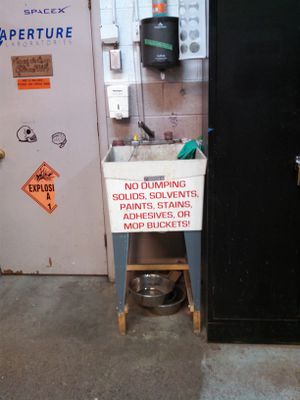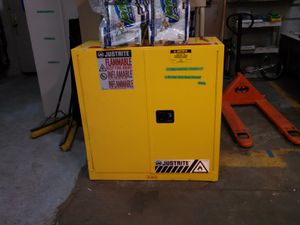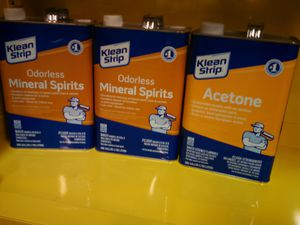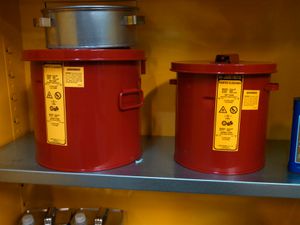Chemical Storage and Disposal
Contents
Disposal
The Justrite Flammables Cabinet in the H-structure has equipment for safe disposal of several hazardous materials in frequent use at i3Detroit. Specific instructions on how to use equipment can be found in the following sections. But for a quick tutorial on disposal methods, check out these pages from the University of Illinois:

Adhesives
Sheets of newspaper and cardboard will be available in the Justrite cabinet. To dispose of any unwanted adhesives:
- Take some cardboard or newspaper out and spread the adhesive in a thin layer
- Find a safe place to allow the adhesive to dry.
- The best approach is to use an cart for temporary use
- Put a note near your adhesive so that people know not touch it
- Be mindful of fumes from the adhesive: use a fan or put the adhesive outdoors if possible to get proper ventilation
- Dispose of the dried adhesive and newspaper or cardboard in i3's dumpster.
Aerosols
Aerosol cans contain hazardous materials under pressure that can explode dangerously when not properly disposed. An aerosol can be emptied of its contents and safely thrown in the dumpster if gas no longer comes out when the nozzle is pressed. Follow these steps to empty and dispose of aerosol cans.
- Start in a well ventilated area with some newspaper, a sheet of cardboard, or an open cardboard box to
- Lay down a drop cloth to stop over spray from contaminating the surroundings - i.e. don't get paint, lube, etc. all over the driveway or workbenches in the space.
- Newspaper and cardboard sheets will be found in the Justrite Flammables Cabinet
- Or you may be able to find a cardboard box near the recycling bins under the graveyard area
- Spray the can onto the paper or cardboard until the can is completely empty
- You can tell the can is completely empty when no gas exits the nozzle when it is depressed
- The can may be empty of paint before the propellant gas is all gone, but you need to make sure that all of the propellant gas is gone
- Allow the paper or cardboard to dry, then dispose of it in the dumpster and put away any drop cloth that was used.
Household Cleaners
From the "University of Illinois 57 Ways":
If a household cleaner contains a solvent, do not dump it down the drain or put it in the trash. It contains solvents if the label includes words such as flammable, combustible, caution, warning, danger, or contains petroleum distillates or aromatic hydrocarbons. Find out if someone else can use it up—as long as the cleaner is in its original container and is properly labeled.
Product contains solvent if:
- Label says flammable, combustible, caution, warning, danger
- Product contains petroleum distillates or aromatic hydrocarbons
Labeling on the cleaner's container should provide the necessary information to determine if the cleaner contains dangerous solvents or not. Please see solvent disposal.
Paint and Solvents
Paint and solvents should not be dumped down any drains. This pollutes water and also causes plumbing issues at i3 when pipes get clogged. You should try to only take what paint and solvent you need, and no more to prevent waste.
Paint (Stain, etc.)
Paints include:
- Water based
- Latex paint
- Acrylic paint
- Other water-based paint
- Oil based
- Paints
- Stain
- Lacquer
- Varnish
Paint disposal approaches:
- Small amounts of paint waste can be dried out on newspaper or cardboard and disposed as solids in the dumpster
- If a large amount of paint needs to be disposed, it can be dried up in the original container or another container by leaving the lid off and occasionally stirring the paint to promote drying - Make sure to allow proper ventilation, especially for oil based paints
- Solvents are often used to clean up paint brushes and trays after work is done, especially for oil based paints
- Please read solvent disposal
- It's ok to use the sink to rinse water based paint out of paint brushes when the paint has been wiped out thoroughly onto newspaper as much as possible beforehand
Solvents
Used and leftover solvents should not be poured down the drain or thrown in the dumpster as a liquid.
Common solvents at i3 include:
- Acetone
- Mineral spirits
- Other solvents, including many household cleaners
i3Detroit has flame proof tanks for used and excess acetone and mineral spirits. These tanks have a special low-melt temperature link that releases in case of a fire to close the container and smother the fire. The tanks should always be stored in the flammables cabinet when not in use.
When you are done using these solvents, you can simply pour the remaining solvent in the correct tank. The tanks are clearly labeled with their contents. The smaller 2 gallon tank for acetone, and the larger 3 gallon tank is for mineral spirits.
The contents of the setting tanks will periodically be skimmed off to allow reuse of solvent, and the sludge left over will be disposed of as solid waste with the use of an absorbent material like sawdust or kitty litter. The reuse solvents will be re-bottled for future use by members at i3Detroit.
Other solvents should not be dumped down drains either. While there are settling tanks for more commonly used solvents, other solvents can be disposed of in small quantities. There are two choices: the solvent can be evaporated with good ventilation, or the solvent can be mixed with an absorbent material like sawdust or kitty litter and disposed of as solid waste in the dumpster.
Automotive Products
i3Detroit is not equipped to dispose of automotive waste products. Please review these recommendations from the University of Illinois, and handle the disposal in an appropriate fashion by your own means. Residents of Oakland County can find the appropriate disposal services at SOCRRA. Other nearby counties have similar waste disposal centers.
Storage
Please make sure all chemical containers are legibly labeled with at least these three things:
- Chemical name (it's amazing how often people forget this) or at the very least the most hazardous component
- Owner's name and contact information (in case we need more information about safe handling)
- The date you stored it (so we can tell if something is abandoned)
While we generally discourage use of particularly hazardous materials in the space, if you do, please include what the primary hazard class is clearly on the label, such as: CORROSIVE, FLAMMABLE, OXIDIZER, EXPLOSIVE, or TOXIC and store chemicals from different hazard classes in separate cabinets and follow storage guidelines on the MSDS or SDS.
Also remember to include information that may be useful to you when you go back to use it, such as:
- Has it been used already?
- What dilution is it?
- What should it be used for?
Containers should be labeled with an actual label adhered to the container, NEVER Sharpied (or Sharpeied) directly onto the container. Marks directly on bottles become illegible much faster than on label material.
Examples:
+--------------------------------------+ | MINERAL SPIRITS 100% | | M. Gardeski (mjgardes@i3detroit.org) | | Filled on 1996-04-12 | | Used for rinsing paint brushes | | IRRITANT | +--------------------------------------+
General advice for household chemical storage:
While we are not presently requiring GHS rules to be followed, it is good for everyone who uses chemicals get to know them.
If you want to be an overachiever, you are welcome use GHS-compliant lables. http://www.mysafetylabels.com/img/art/labeling-table-chart.gif


